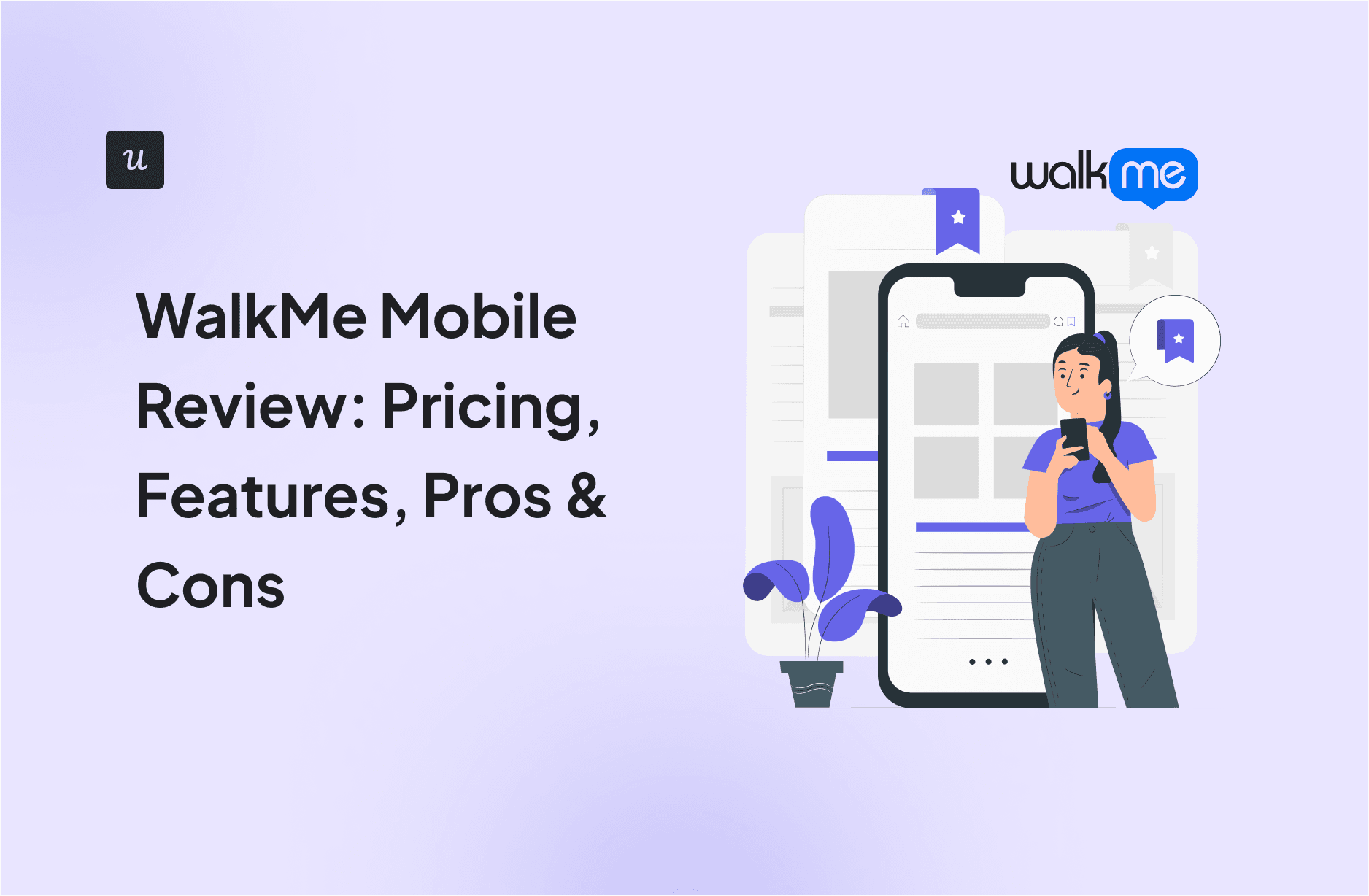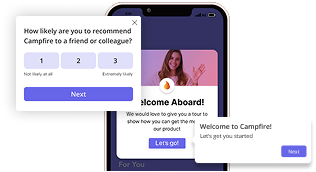
Curious about WalkMe Mobile?
This article provides an in-depth and honest review of the platform. We covered everything from features to pricing, along with insights from real users.
You’ll also see where WalkMe performs best and when another tool might be a better fit for mobile app engagement.
Let’s dive in!
Try Userpilot Now
See Why 1,000+ Teams Choose Userpilot

What is WalkMe Mobile?
WalkMe Mobile is a part of the WalkMe platform built specifically for mobile apps. It helps app owners guide new users, promote feature adoption, and deliver employee training, all within the mobile app experience.
Note: This is different from WalkMe Mobile Web, which applies WalkMe’s web-based guidance to mobile-optimized websites.
Who is WalkMe Mobile best for?
WalkMe Mobile is most suited for large enterprises and compliance-heavy industries. Based on verified Gartner reviews, the majority of its customers use WalkMe to support internal business apps, large-scale field operations, and app rollouts across thousands of employees or users.
The tool is especially valuable for organizations that already use WalkMe for web-based platforms and want to extend the same level of automation to their mobile users.
Core features at a glance: WalkMe Mobile
WalkMe Mobile offers a robust feature set, but below are seven of the most widely used tools:
- Smart Walk-Thrus: This feature helps you provide step-by-step in-app guidance as users interact with your app or its new features for the first time. They reduce time to value by helping users train on the go (as opposed to visiting a knowledge base for every little confusion).
- SmartTips: These are contextual tooltips that appear on specific elements to help users understand what they’re looking at or how to interact with it.
- ShoutOuts and Banners: These features help you capture user attention for announcements, promotions, or critical information. A ShoutOut typically appears as a pop-up or modal in the center of the screen, while Banners are message bars anchored to the top or bottom of the screen.
- Task lists: Also known as Checklists in tools like Userpilot, this feature helps guide users through a series of actions or steps. For example, you could create an onboarding checklist to walk users through the key tasks involved in setting up and using your mobile app.
- Segmentation and targeting: WalkMe lets you create separate user groups for better personalization. For example, you could show a beginner-friendly onboarding flow to first-time users, while directing returning users to advanced tips or feature updates.
- Localization/multilingual support: This feature lets you translate your content into multiple languages and provide a truly native experience for your global users. However, WalkMe doesn’t localize your content. You’ll have to rely on manual translations and exports (which takes time) or use third-party integrations for AI-driven localization.
- Analytics: WalkMe provides detailed insights into user behavior, product usage, and workflow progress. These analytics help you understand how users interact with your app and spot where they may be struggling.
Pricing: WalkMe Mobile
WalkMe Mobile typically comes as part of the full WalkMe platform. There’s no self-serve option available, so interested customers will need to get on a demo call and receive quotes based on their needs.
What’s the price range like? The company isn’t public about its pricing, but transaction data from Vendr shows the average annual cost is around $79,000, with larger contracts reaching over $400,000 per year.
What real users say: WalkMe Mobile pros and cons
Beyond the features and pricing, the true measure of any platform is in its day-to-day use. We’ve gathered feedback from real WalkMe customers to present a candid look at their experiences:
WalkMe Mobile pros
Reliable and easy to build with:
A major upside frequently mentioned by users is how easy it is to create, clone, and manage guidance content, especially across multiple tools.
“The ability to easily create and clone tours is super helpful and has enabled us to quickly launch guides in other tools, and allows us to have an on-going metric to track in-app feedback over time.”

Enterprise-grade control with tangible ROI:
Many enterprise users point to WalkMe’s ability to facilitate training, reduce internal support tickets, and improve data accuracy.
“Training time was saved when we implemented a new product or changed from PeopleSoft to Success Factors. WalkMe helped us to reduce the number of frequently asked queries in the ServiceNow ticketing tool. We could achieve nearly 95% data accuracy using WalkMe.”

WalkMe Mobile cons
Steep learning curve:
The biggest downside for most users is the learning curve.
“One of the main downsides is the learning curve associated with fully unlocking its more advanced features, especially when it comes to designing complex logic-based flows or working with dynamic elements in applications. While basic deployments are straightforward, mastering the platform takes time and often requires more trial and error than expected.”

Note: Some reviewers also mentioned slow or unhelpful customer support, particularly when dealing with more technical issues.
High cost barrier for smaller teams:
Almost all reviews that mentioned price said it was too high:
“This product is very costly, putting it out of reach for most small businesses.”

While WalkMe Mobile delivers value for large enterprises, the trade-offs, like high cost and a steep learning curve, can outweigh the benefits for many teams.
If you’re looking for something more agile and modern, some alternatives offer similar (or even expanded) capabilities without the enterprise overhead. Userpilot is a great example.
WalkMe Mobile vs. Userpilot Mobile
Here’s how the two platforms compare when it comes to features, pricing, and ease of use:
| Feature | Userpilot | WalkMe |
| Onboarding & In-App Engagement | Carousels, slideouts, push notifications | Step-by-step walkthroughs, SmartTips, launchers |
| Surveys | NPS, CES, CSAT, and other survey types | Limited survey types; mostly basic in-app feedback prompts |
| Customization & personalization | Highly customizable UI elements and user targeting rules | Customization requires developer input for more advanced use cases |
| Localization | Manual and AI-powered localization with in-app language control | Manual translation with optional third-party AI integration |
| Ease of use & setup | No-code setup with visual editor | Requires coding knowledge for full functionality |
| Pricing | Transparent pricing and lower entry cost. (The Starter plan is priced at $299/mo, billed annually) | Custom pricing, enterprise-level only |
Why Userpilot is a great WalkMe alternative for mobile apps
Now that you’ve seen the similarities and differences between both tools, let’s explore why Userpilot might be a better and more affordable option for your business:
1. Agile, no-code implementation: Userpilot is built for speed. Its intuitive visual editor empowers product teams to launch, test, and iterate on in-app experiences without requiring developer support. For instance, a talent management platform increased new user activation by 75% within just 10 days of adopting Userpilot. While their product is web-based, the same no-code agility extends to mobile apps as well.
2. Unified web and mobile experience: With Userpilot, your team can effectively track user behavior across web browsers and native mobile platforms from a single, unified dashboard. This eliminates the data silos that often slow down decision-making and makes it easier to align cross-platform experiences.

3. Comprehensive in-app engagement tools: Userpilot’s mobile SDK includes a suite of engagement tools such as carousels, slideouts, and push notifications, for real-time user communication. You can also trigger contextual in-app surveys like NPS, CSAT, and CES to gauge user satisfaction and make data-driven improvements.

4. Advanced segmentation and analytics: Userpilot lets you target users based on their attributes, behaviors, and language preferences, making it easier to deliver experiences that resonate. Beyond segmentation, Userpilot’s analytics give your team real-time visibility into how users are engaging with your content, so you can respond quickly, optimize flows, and improve retention without guesswork.

Final verdict: Should you choose WalkMe Mobile?
WalkMe Mobile is undoubtedly an excellent solution for businesses that prioritize employee training, enterprise control, compliance, and governance at scale.
However, Userpilot offers a more compelling solution if you’re a startup or mid-market company focused on user onboarding, engagement, and retention. Our platform is optimized for speed and faster UX iterations. Ready to see it in action? Book a free demo to begin.
FAQ
What is WalkMe used for?
WalkMe is a digital adoption platform (DAP) for onboarding, training, and supporting users in web and mobile apps.
What is the difference between WalkMe and Whatfix?
Both WalkMe and Whatfix are DAPs, but WalkMe is typically more enterprise-focused, with deeper customization and governance features. Whatfix is often considered easier to implement, with a faster setup process.
Who uses WalkMe?
WalkMe is used by large enterprises across various industries, including healthcare, finance, insurance, retail, and technology.








